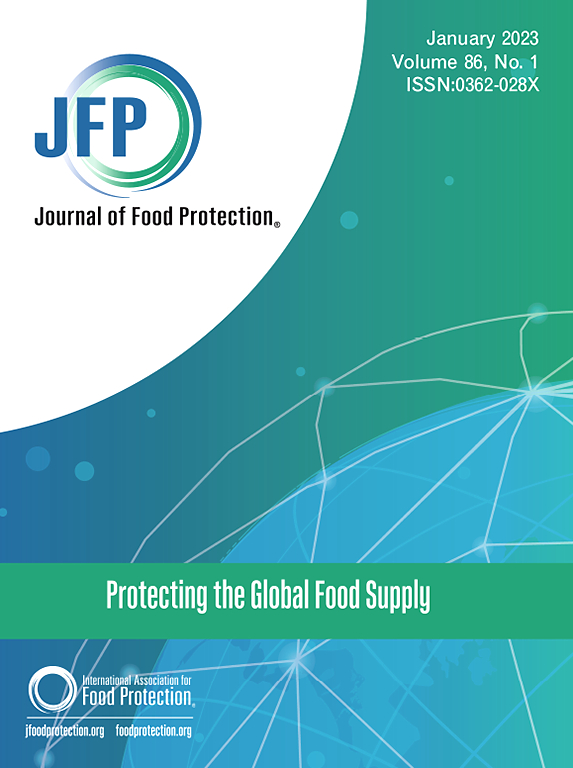Analysis of Outbreak Data Reveals Factors Contributing to Salmonellosis Outbreaks Linked to Cantaloupes
IF 2.1
4区 农林科学
Q3 BIOTECHNOLOGY & APPLIED MICROBIOLOGY
引用次数: 0
Abstract
Over the last thirty years, the presence of Salmonella spp. on cantaloupes has been linked to multiple large and deadly foodborne outbreaks in multiple countries. To identify factors associated with the number of cases and risk of severe illness in these outbreaks, information from previous melon-associated salmonellosis outbreaks was analyzed. Data were collected from sixty outbreak investigations. Compared to other melon types, such as watermelon, honeydew, and Galia melon, cantaloupes had the highest public health burden. Cantaloupes were implicated in 43% of reported melon-related outbreaks, 51% of melon-related laboratory-confirmed cases, 54% of melon-related hospitalizations, and 76% of melon-related deaths. In the United States, imported cantaloupes were associated with higher rates of severe salmonellosis and a greater diversity of Salmonella spp. serovars compared to domestically grown cantaloupes. Cantaloupes implicated in outbreaks were equally likely to have been consumed in either private or public settings. Larger outbreaks were associated with the consumption of precut cantaloupe and/or the consumption of cantaloupes in public settings. With the identification of these contributing factors, a literature search was conducted to assess the state of knowledge concerning Salmonella and cantaloupes. Several gaps in the literature were noted and are discussed in the context of reducing the number of illnesses associated with the presence of Salmonella on cantaloupes.
疫情数据分析揭示了导致与哈密瓜有关的沙门氏菌病爆发的因素。
在过去的三十年里,哈密瓜上的沙门氏菌与多个国家发生的多起大规模致命食源性疾病暴发有关。为了确定这些疫情中与病例数量和严重疾病风险相关的因素,我们分析了以前与甜瓜相关的沙门氏菌病疫情的信息。我们从 60 起疫情调查中收集了数据。与西瓜、蜜瓜和加里亚瓜等其他瓜类相比,哈密瓜的公共卫生负担最高。在报告的瓜类疫情中,43%与哈密瓜有关,51%的实验室确诊病例与哈密瓜有关,54%的住院病例与哈密瓜有关,76%的死亡病例与哈密瓜有关。在美国,与国产哈密瓜相比,进口哈密瓜的严重沙门氏菌病发病率更高,沙门氏菌属血清型的多样性也更大。暴发疫情的哈密瓜同样可能是在私人或公共场所食用的。规模较大的疫情爆发与食用预切哈密瓜和/或在公共场所食用哈密瓜有关。在确定了这些诱因后,我们进行了文献检索,以评估有关沙门氏菌和哈密瓜的知识状况。我们注意到文献中存在一些空白,并结合减少与哈密瓜上沙门氏菌有关的疾病数量进行了讨论。
本文章由计算机程序翻译,如有差异,请以英文原文为准。
求助全文
约1分钟内获得全文
求助全文
来源期刊

Journal of food protection
工程技术-生物工程与应用微生物
CiteScore
4.20
自引率
5.00%
发文量
296
审稿时长
2.5 months
期刊介绍:
The Journal of Food Protection® (JFP) is an international, monthly scientific journal in the English language published by the International Association for Food Protection (IAFP). JFP publishes research and review articles on all aspects of food protection and safety. Major emphases of JFP are placed on studies dealing with:
Tracking, detecting (including traditional, molecular, and real-time), inactivating, and controlling food-related hazards, including microorganisms (including antibiotic resistance), microbial (mycotoxins, seafood toxins) and non-microbial toxins (heavy metals, pesticides, veterinary drug residues, migrants from food packaging, and processing contaminants), allergens and pests (insects, rodents) in human food, pet food and animal feed throughout the food chain;
Microbiological food quality and traditional/novel methods to assay microbiological food quality;
Prevention of food-related hazards and food spoilage through food preservatives and thermal/non-thermal processes, including process validation;
Food fermentations and food-related probiotics;
Safe food handling practices during pre-harvest, harvest, post-harvest, distribution and consumption, including food safety education for retailers, foodservice, and consumers;
Risk assessments for food-related hazards;
Economic impact of food-related hazards, foodborne illness, food loss, food spoilage, and adulterated foods;
Food fraud, food authentication, food defense, and foodborne disease outbreak investigations.
 求助内容:
求助内容: 应助结果提醒方式:
应助结果提醒方式:


